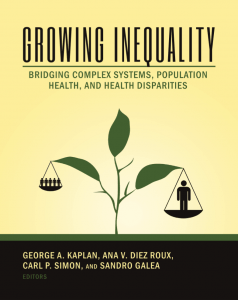Book Review: Complex Systems and Population Health: Insights from the Network on Inequality, Complexity and Health
Jose PaganBook review
Dr. Jose Pagan reviews “Growing Inequality: Bridging Complex Systems, Health Disparities, and Population Health”
Differences in health within and across population groups exist as a result of multiple, interconnected factors. These factors range from the individual risk of disease all the way to the social and economic policies that shape our context and the characteristics of the communities we work and live in. The multilevel nature of the determinants of population health is a relatively easy concept to grasp, but it is much more challenging to understand how these determinants are precisely connected at multiple levels.
Complex systems methodologies such as agent-based modeling, system dynamics, and discrete event simulation have been around for decades, but their application to understanding the causes and consequences of health disparities is much more recent. Growing Inequality: Bridging Complex Systems, Health Disparities, and Population Health (Kaplan et al. 2017) brings together the work of eighteen scholars that in 2010 formed the Network on Inequality, Complexity and Health, a transdisciplinary team of researchers committed to understanding health inequality and its complexities. The work was supported by the Office of Behavioral and Social Science Research at the National Institutes of Health.
Agent-based modeling
The book addresses health inequality issues using primarily agent-based modeling,  providing the reader with a broad selection of the types of research questions that can be asked and the different insights obtainable with the use of systems science. The book includes applications related to disparities in obesity, primary care, physical activity, school choice, crime, oral health, and use of mobile technologies, among others. I won’t summarize each individual application but, rather, I’ll focus on one example of an agent-based model discussed in the book. I believe this model provides important insights to anyone interested in understanding the potential of complex systems methodologies to address research questions related to reducing health disparities.
providing the reader with a broad selection of the types of research questions that can be asked and the different insights obtainable with the use of systems science. The book includes applications related to disparities in obesity, primary care, physical activity, school choice, crime, oral health, and use of mobile technologies, among others. I won’t summarize each individual application but, rather, I’ll focus on one example of an agent-based model discussed in the book. I believe this model provides important insights to anyone interested in understanding the potential of complex systems methodologies to address research questions related to reducing health disparities.
In Chapter 3, Mark G. Orr, Sandro Galea, and George A. Kaplan use an agent-based model to determine whether improving neighborhood food, exercise, and education environments may reduce differences in obesity between non-Hispanic whites and blacks in the United States. The model includes a high level of detail on individual behaviors, agent and neighborhood characteristics, friendship networks, and residential mobility, and is designed to mimic what happens over time to agents residing in neighborhoods with varying types of race and income distributions. Orr, Galea, and Kaplan found, for example, that policies related to school quality and physical activity were related to reductions in obesity for blacks, but not as much as for whites. What I believe is more useful in this chapter, though, to anyone interested in complex systems and health, is the importance of a life-course perspective and how residential mobility and social influences matter to understanding differences in obesity across population groups. Another important, non-obvious insight from their work is that agent-based modeling requires the careful specification of all the parameters, linkages, and rules, which in turn brings clarity to a problem and helps to identify knowledge gaps.
Tools for your toolbox
Growing Inequality: Bridging Complex Systems, Health Disparities, and Population Health is a must read for anyone interested in the potential of complex systems methodologies to better understand population health and health disparities. Although the chapters in this book do not perfectly mesh at times—edited volumes rarely do so!—the book introduces the reader to complex systems approaches that increasingly will be visible in population health science research and that may even become part of your methodological toolbox. I have used agent-based models to simulate how lifestyle changes may impact the incidence and progression of diabetes and cardiovascular disease; this new book introduced me to several complex systems approaches that I had not considered before and that I surely plan to investigate in the near future.
Seven core observations
Finally, for those of you interested in pursuing this path of discovery, I strongly urge you to pay attention to the seven “core observations” of Sandro Galea, Ana V. Diez Roux, Carl P. Simon and George A. Kaplan in Chapter 14 of their book. These words of wisdom boil down to making sure that you are: (1) asking the right questions to generate new insights from complex systems approaches, (2) striving to develop a shared transdisciplinary language, (3) attempting to connect models to real life, (4) keeping models as simple as possible to answer a particular question, (5) considering using models to compare different scenarios that impact health, (6) using models to bring clarity to a problem, and (7) thinking about how complex systems approaches can be used to translate and communicate knowledge to broader audiences about what drives population health and health disparities.
References and Resources
Kaplan GA, Diez Roux AV, Simon CP, and Galea S, Eds. 2017. Growing Inequality: Bridging Complex Systems, Population Health and Health Disparities. Washington, DC: Westphalia Press. (reviewed above)
Frerichs L, Lich KH, Dave G, Corbie-Smith G. 2016. Integrating systems science and community-based participatory research to achieve health equity. American Journal of Public Health. Feb;106(2):215-22. https://www.ncbi.nlm.nih.gov/pmc/articles/PMC4815818/pdf/AJPH.2015.302944.pdf
Li Y, Pagán JA. The Culture of Health Action Framework and Systems Science: Opportunities and Challenges. Health Affairs Blog. October 17, 2016. http://healthaffairs.org/blog/2016/10/17/the-culture-of-health-action-framework-and-systems-science-opportunities-and-challenges/
Li Y, Lawley MA, Siscovick DS, Zhang D, Pagán JA. 2016. Agent-based modeling of chronic diseases: a narrative review and future research directions. Preventing Chronic Disease May 26;13:E69. https://www.ncbi.nlm.nih.gov/pmc/articles/PMC4885681/pdf/PCD-13-E69.pdf
Maglio PP, Sepulveda MJ, Mabry PL. 2014. Mainstreaming modeling and simulation to accelerate public health innovation. American Journal of Public Health Jul;104(7):1181-6. https://www.ncbi.nlm.nih.gov/pmc/articles/PMC4056212/pdf/AJPH.2014.301873.pdf





All comments will be reviewed and posted if substantive and of general interest to IAPHS readers.